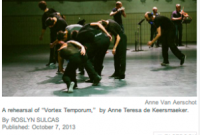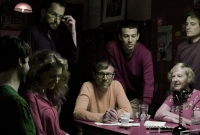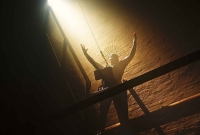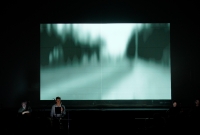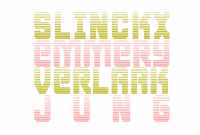More Press
BOCHUM, Germany — In the early 1980s, the Belgian choreographer Anne Teresa De Keersmaeker established herself as a take-no-prisoners dance-maker of rigorous, formalist sensibility and innate theatricality. Her women wore short skirts that revealed their underwear, and heels or boots — at once rough schoolgirls and tough businesswomen. Her men, looser and more relaxed, were both willing prey and mysterious sources of desire.
But Ms. de Keersmaeker’s work and aesthetic have changed over the past decade. The schoolgirls have gone, the feminist assertion of the movement is no longer an obvious element, the overt theatricality of early pieces has also disappeared. What Ms. de Keersmaeker’s past several works have shown is a stripping down to essentials; the body, the breath, pure sound, pure movement.
What has remained constant, however, is an intense relationship to music and musicians. Her new production, “Vortex Temporum,” which had its premiere as part of the Ruhrtriennale festival last week, sustains and extends that focus. The presence of the contemporary Ictus Ensemble onstage is as important as the dancers.
The title of the work comes from a 1996 score of the same name by Gérard Grisey, a French composer who was a leading proponent of a musical movement known as spectralism, which prioritized pure sound and its transformations over the formal preoccupations of the serialist composers. Music, said Grisey (who died in 1998 at 52) is made with sounds, not notes. You might say that Ms. de Keersmaeker’s movement in “Vortex” is made with movement, not steps.
The work begins with the sound alone. Six musicians, on piano (Jean-Luc Plouvier), flute (Michael Schmid), clarinet (Dirk Descheemaeker), violin (Igor Semenoff), viola (Jeroen Robbrecht) and cello (Geert De Bièvre) — walk into the vast space in the Jahrhunderthalle (a former steel factory that is a central site for the Triennale), sit down and plunge straight into the music. The immediate impact is an assault on the senses. Melody and rhythm emerge at different moments, then disappear; the piano pounds and trills, one instrument picks up from another in a blur of sonorities.
Mr. Plouvier’s dazzling glissandi are interspersed with the kind of crashes you might make (as does a dancer later) if you simply banged the piano with reckless abandon. Except nothing in this music is arbitrary, and you can only marvel at the prowess and rigor of the musicians, playing through this thicket of complexity without a score or a conductor.
After the first movement, the musicians walk off as abruptly as they arrived, replaced by seven dancers (Bostjan Antoncic, Carlos Garbin, Marie Goudot, Cynthia Loemij, Julien Monty, Michael Pomero and Igoy Shyshko) who form a rough semicircle. They stand still for a little while, then almost imperceptibly begin to drop their heads and shoulders forward, eventually spiraling down to the floor in different time frames, often in pairs that fragment and reform. A man standing apart begins little skittering runs and small jumps; when the musicians rejoin the dancers and begin to play, it’s almost shocking how perfectly the movement fits rhythms in the music that you might not have known existed.
The most striking aspect of “Vortex” is how it changes the audience’s perception of music, enhancing it through the bodies of the dancers. The movement does not, at first, appear especially complex. Ms. de Keersmaeker deploys spiraling patterns, both on individual bodies and larger group organization, in multiple configurations, and the vocabulary — based on walking, running, turning, dropping, leaping — seems simple. But the harder you look, the more individual detail you see in each dancer’s motion, which often seems matched to a specific instrument.
Midway through this second movement, the musicians begin to move with their instruments (the piano is wheeled in circles around the stage by two dancers) so that they two become part of the universe of motion. In a final section, things slow, sonically, almost to the point of inaudibility. It’s as if the musicians are producing the sound of breathing through their instruments.
The lights dim as the dancers move slowly, bending, twisting, backing up to the far walls of the wide space. It is finally dark and silent — or is it? Grisey’s sound has so stretched perceptions that it’s hard to be sure.
There are criticisms you could level at “Vortex.” It’s terribly hard work; it asks a great deal of its audience; it is utterly dry and no fun at all. But that Ms. de Keersmaeker could even contemplate choreographing to this music, and then go on to make it legible and thrilling, is a triumph.
NL "Nothing in this music is arbitrary, and you can only marvel at the prowess and rigor of the musicians, playing through this thicket of complexity without a score or a conductor."
" That Ms. de Keersmaeker could even contemplate choreographing to this music, and then go on to make it legible and thrilling, is a triumph."
Roslyn Sulcas, The New York Times
FR "Nothing in this music is arbitrary, and you can only marvel at the prowess and rigor of the musicians, playing through this thicket of complexity without a score or a conductor."
" That Ms. de Keersmaeker could even contemplate choreographing to this music, and then go on to make it legible and thrilling, is a triumph."
Roslyn Sulcas, The New York Times
DE "Nothing in this music is arbitrary, and you can only marvel at the prowess and rigor of the musicians, playing through this thicket of complexity without a score or a conductor."
" That Ms. de Keersmaeker could even contemplate choreographing to this music, and then go on to make it legible and thrilling, is a triumph."
Roslyn Sulcas, The New York Times
